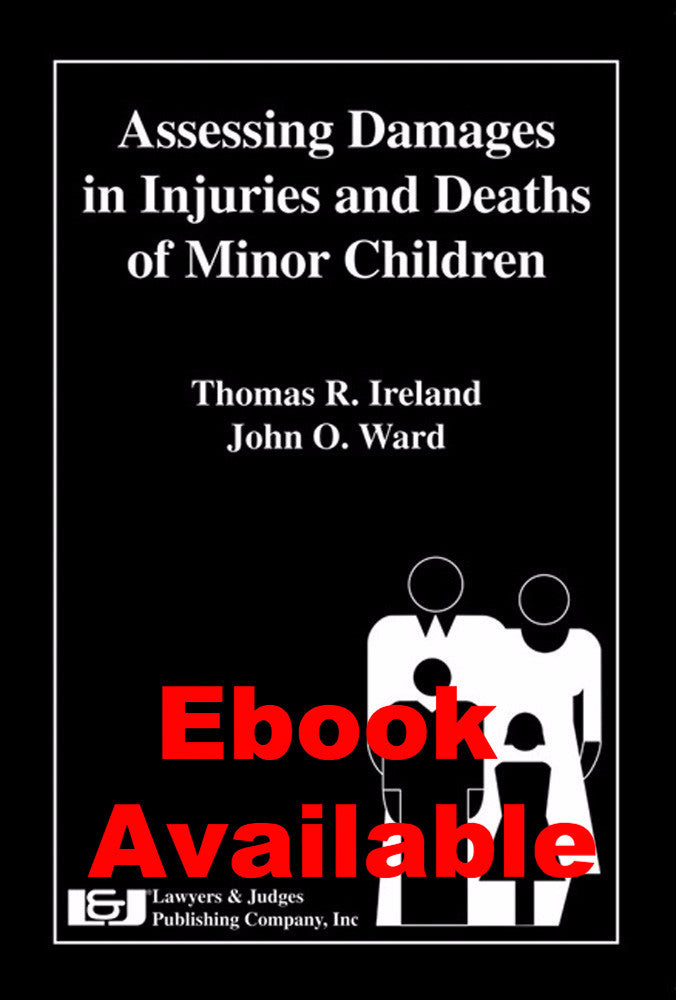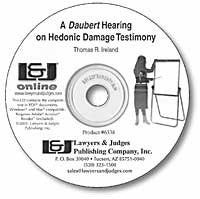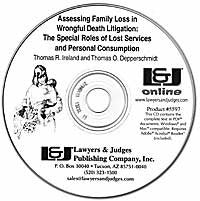
Assessing Damages in Injuries and Deaths of Minor Children
-
Authors: Thomas R. Ireland, John O. Ward; Contributors: Anne E. Winkler, Sumner LaCroix, Linda G. Martin, William E. Hardy, Jr., Lawrence M. Spizman, John Kane, Andrew M. Gill, Jack Foley, Christopher A. Jepsen, Lisa K. Jepsen, Mark Lino, Ralph J. Brown, R. Mark Rogers, Donald J. Bieniewicz
-
ISBN 10: 1-930056-18-4
-
ISBN 13: 978-1-930056-18-3
-
Copyright Date Ed: July 10, 2002
-
Pages: 407
-
Binding Information: Paperback
- Size: 6 ✕ 9 Inches (US)
When you have a case that deals with the sad event of the death of a child, how do you determine how much the amount of damages should be? What statistics do you use, and how do you arrive at the final amount?
Assessing Damages in Injuries and Deaths of Minor Children's primary focus is to consider a wide range of topics that relate to how to assess damages or provide testimony in cases involving injuries or deaths of minor children.
Written with the forensic economic expert or attorney specifically concerned with damages in mind, this book goes in depth on every approach to assessing damages in these cases. You will learn how to assess damages using the parental investment approach, how to determine a child's future earning capacity by taking into account the educational outcomes of the parents, and other ways to project a child's future earning capacity. You will read about the issues of wrongful birth and wrongful pregnancy. You will also find out by using the Child Support Guidelines how child support paid after a divorce can be factored into a damages assessment. Read about damages standards in various types of litigation involving personal injuries and wrongful deaths of children.
Be introduced to a variety of methodologies for projecting the lost earnings of a minor child, including the future financial support a decedent child might have provided to parents. Learn about the fundamental damages problem in the death of a minor child, which is that parents have losses of enormous value which they would have been willing to expend almost all financial resources to prevent, but standards for financial damages recovery tend to be very small.
Topics covered:
- Predicting educational attainment
- Parental effects on a child's educational attainment
- Parental influence on a child's future earnings
- Damages in wrongful pregnancy tort actions
- Damages in wrongful birth litigation
- Future economic contributions of a female child
- Using national opinion research data
- The parental investment approach
- U.S. Department of Agriculture estimates
- Saving rate estimates for single persons by income, age and sex
- Applying Cost Share
- Child Support Guidelines
- Using the Expenditures on Children report
Table of Contents
Assessing Damages in Injuries and Deaths of Minor ChildrenEdited by Thomas R. Ireland and John O. Ward
Table of Contents
Reading 1: Introduction
1.1 The Purpose of This Book
1.2 Changes from Our Previous Book
1.3 The Special Role of Reading 2
1.4 The Organization of This Book
Reading 2: Evaluating Child Loss in Child Injuries and Fatalities: Roles of an Economic Expert
Thomas R. Ireland and John O. Ward
2.1 Introduction
2.2 Damages Standards in a Typical Personal Injury to a Child
A. The basic structure of a personal injury damages analysis for a child
1. Elements of a personal injury analysis for a child
2. Development of an earnings loss basis for a child
3. Use of a net discount rate method with statistical worklife tables
4. Alternative methods for dealing with wage increases and discount rates
5. Methods for dealing with periods of capacity for damages
B. Educational scenarios for a child's earnings loss
1. Preinjury assessment
2. Choosing reasonable preinjury scenarios
3. Postinjury assessment
4. Composite scenarios
5. Career track and "mommy track" scenarios for female children
6. The final steps in a lost earnings calculation
2.3 Damages Standards for the Wrongful Death of a Child
A. The fundamental damages problem in the death of a minor child
1. Losses in conventional wrongful death actions
2. Losses in pure survival actions states
3. Losses in personal maintenance states
B. The lost accumulations-to-an-estate approach
C. The parental investment approach
2.4 Remaining Issues
A. Parental loss of consortium in a personal injury--the Gallimore case
B. Wrongful pregnancy or wrongful birth
2.5 Jack Ward's Sample Letter to a Client for a Wrongful Death Case
Endnotes
References
Tables
Reading 3: Projecting the Lost Future Economic Contributions of a Female Child: Refining Income Data to Reflect True Losses
Thomas R. Ireland and Anne Winkler
3.1 Introduction
3.2 Human Capital, Families and Household Production
3.3 A Review of Sex Differences in Earnings Data
3.4 Problems in Estimating Lost Earning Capacity for a Female Child
3.5 Problems in Computing Lost Earnings for a Female Child
3.6 Earnings Comparisons for Women Based on Family Status
3.7 The Compromise of Projecting Earnings from Never-Married Women
3.8 How Damage Estimates Were Prepared
3.9 Conclusion
Endnotes
References
Reading 4: A Refinement in Earnings of Never-Married Females
Hugh Richards
4.1 Introduction
4.2 Ireland and Winkler Revisited
4.3 Data Source, Methodology, and Advantages
4.4 Results
A. CPS versus census earnings differentials
B. Detailed summaries by race
4.5 Summary
References
Reading 5: Damages in Wrongful Pregnancy Tort Actions
Sumner J. LaCroix and Linda G. Martin
5.1 Wrongful Life, Wrongful Birth, and Wrongful Pregnancy Torts
A. Wrongful life
B. Wrongful birth
C. Wrongful pregnancy
5.2 Recovery for the Cost of Raising a Child
5.3 Calculating Child-Rearing Costs
A. Timing and probability of an additional child
B. Specification of the stream of costs for raising a child
5.4 Recovery of Mother's Lost Earnings
A. General considerations
B. The special case of teenagers
5.5 Directions for Future Research
Endnotes
References
Reading 6: Recent Appellate and Supreme Court Decisions Dealing with the Recovery of Damages in Wrongful Birth Litigation
Thomas R. Ireland and John O. Ward
6.1 Federal
6.2 State
Reading 7: Use of National Opinion Research Center Data when Estimating Lost Earning Capacity of an Injured Child
William E. Hardy, Jr.
7.1 Introduction
7.2 The NORC General Social Survey
7.3 Educational Attainment Data
7.4 Case Example
7.5 Projected Earnings Absent Injury
7.6 Savings of College Expenses
7.7 Expected Earnings
7.8 Summary of Lost Earning Capacity
7.9 Summary
Endnotes
References
Reading 8: Loss of Future Income in the Case of Personal Injury to a Child: Parental Influence on a Child's Future Earnings
Lawrence M. Spizman and John Kane
8.1 Introduction
8.2 The Model
8.3 Data
8.4. Empirical Results
8.5 Examples
A. Case A
B. Case B
8.6 Conclusions
Endnotes
References
Reading 9: Predicting Educational Attainment for a Minor Child: Some Further Evidence
Andrew M. Gill and Jack Foley
9.1 Introduction
9.2 The Model
9.3 The Data
9.4 Analytical Strategy
9.5 Results
9.6 Conclusion
Endnotes
References
Appendix
Reading 10: An Update of the Educational Attainment Model for a Minor Child
Lawrence M. Spizman and John Kane
10.1 Introduction
10.2 Why an Update?
10.3 The Model
10.4 The Data
10.5 Empirical Results
10.6 Comparison of Predicted Educational Attainment
10.7 Conclusions
Endnotes
References
Reading 11: Re-examining the Effects of Parental Characteristics on Educational Attainment for a Minor Child
Christopher A. Jepsen and Lisa K. Jepsen
11.1 Introduction
11.2 Model
11.3 Data
11.4 Estimation Strategy
11.5 Results
11.6 Conclusion
Endnotes
References
Appendix
Reading 12: The Investment Approach to Parental Loss in the Death of a Child: A Guide to Understanding Alternative Versions
Thomas R. Ireland and John O. Ward
12.1 Overview of the Investment Approach
12.2 Alternative Versions of the Investment Approach
A. The Wycko-Posner approach
B. The Gray approach
C. The Ireland-Ward approach
D. The net future parental investment approach
12.3 The Quah-Reiber Alternative to the Investment Approach
12.4 Concluding Remarks
Endnotes
References
Reading 13: The Gallimore Case: Applications to Personal Injuries of Children
Thomas R. Ireland and John O. Ward
Reading 14: USDA Data on Costs of Raising a Child
Thomas R. Ireland and John O. Ward
Appendix: Expenditures on Children by Families: 2000 Annual Report
Reading 15: USDA's Expenditures on Children by Families Project: Uses and Changes over Time
Mark Lino
15.1 Uses of Expenditures on Children Report
A. Child support
B. Foster care
C. Educational and other uses
15.2 Estimating Childrearing Expenses: Similarities and Differences over Time
A. Similarities
B. Differences
15.3 Changes in Expenditures on Children: 1960 versus 2000
15.4 Future Plans
References
Reading 16: A Short Guide for Using the Expenditures on Children Report to Prepare a Parental Investment Analysis
Thomas R. Ireland and John O. Ward
16.1 Introduction
16.2 Understanding Direct and Indirect Costs of Raising a Child
16.3 Using Expenditures on Children by Families
16.4 Background for the Ward Report
16.5 Background for the Ireland Report
16.6 Similarities and Differences between the Two Reports
16.7 Issues Involved in Using the Parental Investment Approach
References
Appendix A
Appendix B
Reading 17: The Traditional Model for Parental Loss in the Death of a Child
Thomas R. Ireland and John O. Ward
17.1 Introduction
17.2 Standard Calculations in the Traditional Model
17.3 The Offset Issue
17.4 The Quasi-Collateral Source Issue with Offsets
17.5 Conclusion
Endnotes
References
Cases
Reading 18: Saving Rate Estimates for Single Persons by Income, Age and Sex
Ralph J. Brown
18.1 Introduction
18.2 The Consumer Expenditure Survey Data
A. The treatment of consumer durables
B. The treatment of Social Security and pension plans
18.3 Regression Results
18.4 Saving Rates by Income, Age, and Sex
18.5 Summary and Conclusions
Reading 19; Lost Accumulations to an Estate in a Child Death Case
Thomas R. Ireland and John O. Ward
19.1 Survival of Action Legislation
19.2 Loss of Accumulations to an Estate
19.3 Two Cases Explaining Differences in Standards for Recovery
19.4 Specific Prohibitions of Lost Inheritance in Wrongful Death Actions
19.5 Conclusion
Cases
Reading 20: Child Cost Economics and Litigation Issues: An Introduction to Applying Cost Shares Child Support Guidelines
R. Mark Rogers and Donald J. Bieniewicz
20.1 Introduction
20.2 Review of Current Child Support Guidelines and Their Flawed Economic Foundations
A. Origins of child support guidelines in general use by the states
B. Origin and original intent of the percent of obligor income model (Wisconsin-style)
C. Van der Gaag's definition of child costs
D. Wisconsin's guidelines were never intended by the original researchers to apply to situations other than low income or low benefits
E. Origins and methodology of income shares child support guidelines
F. Reasons behind income shares model's overstatement of child costs
G. The myth that income shares estimates of child costs are low
20.3 Favored Tax Treatment for Custodial Parents and Treating Tax Benefits as a Cost Offset
A. Differences in tax treatment between head of household/custodial parent versus single taxpayer/noncustodial parent
B. The effect of tax benefits on each parent's ability to pay shares of child costs
20.4 Introduction to an Economic Based Child Support Model: Cost-shares--An Expenditure Based Model
A. Basic steps in the cost-shares model
B. Underlying data for the cost-shares child support model
C. An example of applying the cost-shares methodology
D. Which income basis: Why average income instead of combined income?
E. Miscellaneous issues in applying the cost-shares model
1. Child care, medical expenses, and other as above the line or below the line expense
2. Child support adjustments for joint custody and for crediting the noncustodial parent for noncustodial parenting time
20.5 Child Support Determination--What Should the Role Be for a Forensic Economist?
A. Showing a divergence from guideline economic presumptions
1. Contrasting the instant case from obligor-only assumptions
2. Contrasting the instant case from income shares methodology (Betson-Rothbarth) assumptions
B. Lack of quantified case law or statutory standard for proving rebuttal
20.6 Notes on Economic Background and Comparisons with Guidelines and Guideline Awards
Endnotes
References
Appendix A: Child Costs Based on Cost-shares Methodology
Appendix B: Federal Regulations on Child Support
Reading 21: Expenditures on Children by Families: U.S. Department of Agriculture Estimates and Alternative Estimators
Mark Lino
14.1 USDA Estimates of Expenditures on Children by Families
A. Methodology
B. Findings
C. Adjustments for older children and household size
D. Single-parent families
14.2 USDA Child-Rearing Expense Estimates Compared with Other Estimators
14.3 Conclusion
Endnotes
About the Authors
Index




